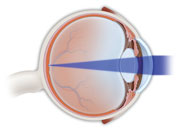Written by: Kierstan Boyd Reviewed by: Denise Satterfield MD Sep. 01, 2013
Astigmatism is an imperfection in the curvature of the cornea (the transparent dome covering the iris and pupil of the eye), or in the lens (crystalline) structure of the eye. Normally, the cornea and lens are smooth and curved equally in all directions, which helps focus the rays of light pronouncedly and correctly towards the retina, at the back of the eye. However, if the cornea or lens is not homogeneously curved or soft, light rays are not refracted correctly. This is called refractive error.
When the cornea has an irregular shape, the condition is called corneal astigmatism. When the shape of the lens is distorted, the condition is called lenticular astigmatism. As a result of any of these types of astigmatism, the near or far view of objects becomes blurred or distorted. It’s like looking at yourself in a house of mirrors, where you look too tall, too broad, or too thin.
You can be born with astigmatism. In fact, most people are probably born with some degree of astigmatism, and have it in conjunction with other refractive defects: myopia or farsightedness.
While adults with a higher degree of astigmatism may realize that their vision is not as good as it should be, children who have symptoms of astigmatism may not be aware of the presence of the condition, and it’s likely that they won’t complain of having blurred or distorted vision. But if astigmatism is not corrected, it can seriously affect a child’s ability to perform well in school and in sports. That is why it is crucial for children to have regular eye exams, to allow the early detection of astigmatism or other vision problems as soon as possible.

In a normal eye, the cornea and lens focus light rays on the retina.
When there is astigmatism, the images focus in front and beyond the retina, causing both near and far vision to become blurred.
What causes astigmatism?
Written by: Kierstan Boyd Reviewed by: Denise Satterfield MD Sep. 01, 2013
Astigmatism is caused by an irregular curvature of the cornea or lens. If the cornea or lens is not smooth and its curvature is not even, the light rays are not refracted correctly. This is called refractive error. Astigmatism is a type of refractive error, which causes blurred or distorted vision at close and far distances.
Astigmatism is very common. In most cases, people with astigmatism are born with this condition. The reason why the shape of the cornea is different from person to person is unknown, but the likelihood of developing astigmatism is hereditary.
Occasionally, astigmatism can be caused by an injury, illness, or eye surgery. It is a myth that astigmatism develops or worsens due to activities such as reading in low light, or sitting very close to the TV.
Symptoms of Astigmatism
Written by: Kierstan Boyd Reviewed by: Denise Satterfield MD Sep. 01, 2013
Symptoms of astigmatism may include blurred vision or distorted areas of vision, visual fatigue, headaches, narrowing of the eyes to try to see clearly, or discomfort in the eyes.
Having these symptoms does not necessarily mean you have astigmatism, but it does indicate a need to visit your ophthalmologist for a complete eye exam.
Diagnosing Astigmatism
Written by: Kierstan Boyd Reviewed by: Denise Satterfield MD Sep. 01, 2013
Your ophthalmologist will do a complete eye exam, and will use various instruments to measure the way your eye focuses light.
They will measure your clarity of vision, asking you to read the letters in a distance box, and thus determine the clarity of your vision at a certain distance. The ability or power of focus will also be examined with a series of lenses placed in front of your eyes.
The curvature of the cornea will be measured with a keratometer. Corneal topography can be used to provide additional information about the shape of the surface of the cornea.
With these tests, your ophthalmologist can diagnose astigmatism and can determine the kind of eyeglasses or contact lenses prescription you need in order to have a clear vision. Other treatment options will also be discussed, such as an astigmatism surgery.
Astigmatism Treatment
Written by: Kierstan Boyd Reviewed by: Denise Satterfield MD Sep. 01, 2013
In general, mild to moderate astigmatism can be corrected with glasses or contact lenses. In the past, astigmatism contact lenses could only be rigid lenses (RGP or GP lenses), but this is no longer the case. Now soft lenses called toric contact lenses can be used, which can correct astigmatism. However, while toric contact lenses may be appropriate for some people, if you have severe astigmatism, rigid contact lenses or a pair of glasses may be a better option. Your ophthalmologist will explain your lens options.